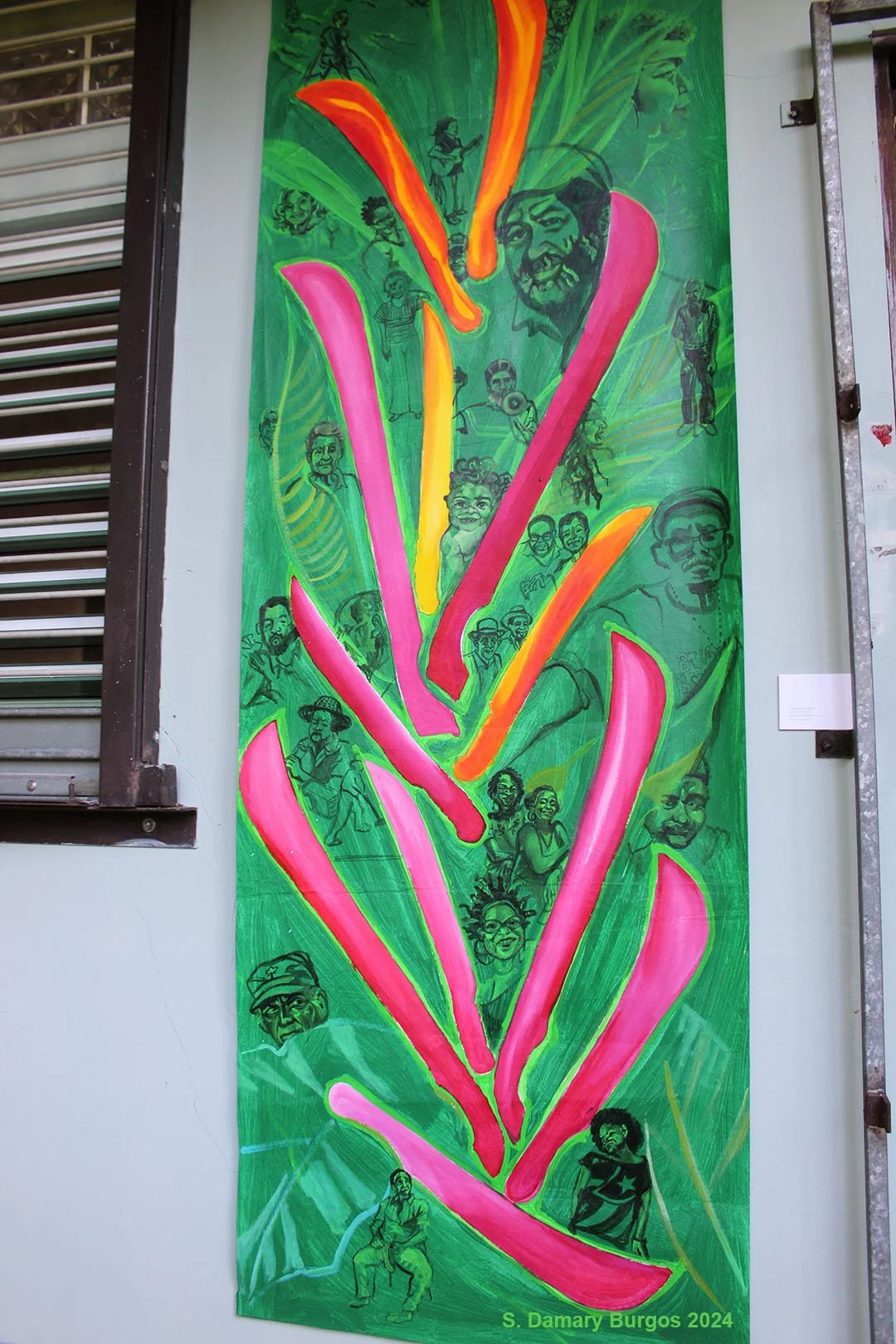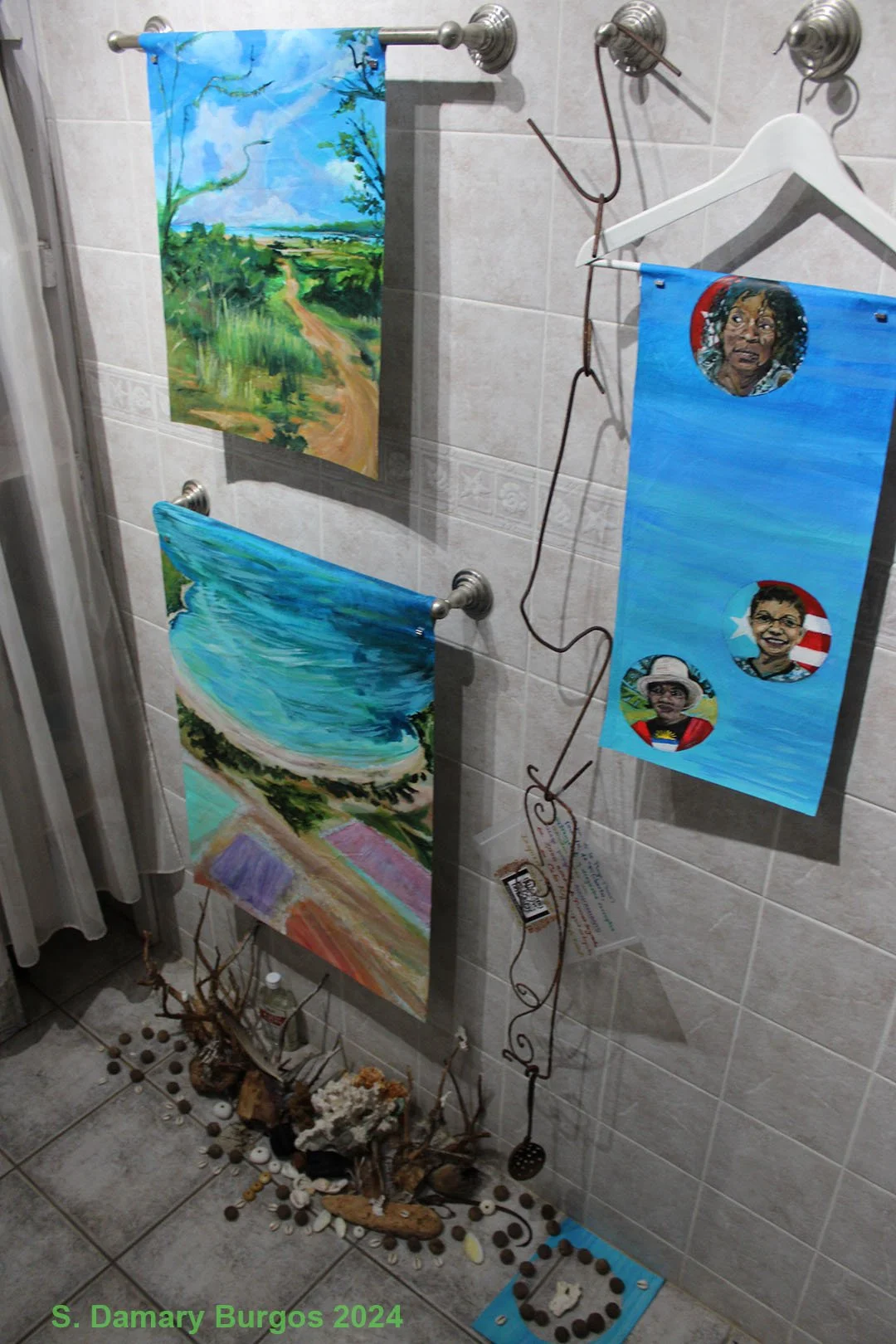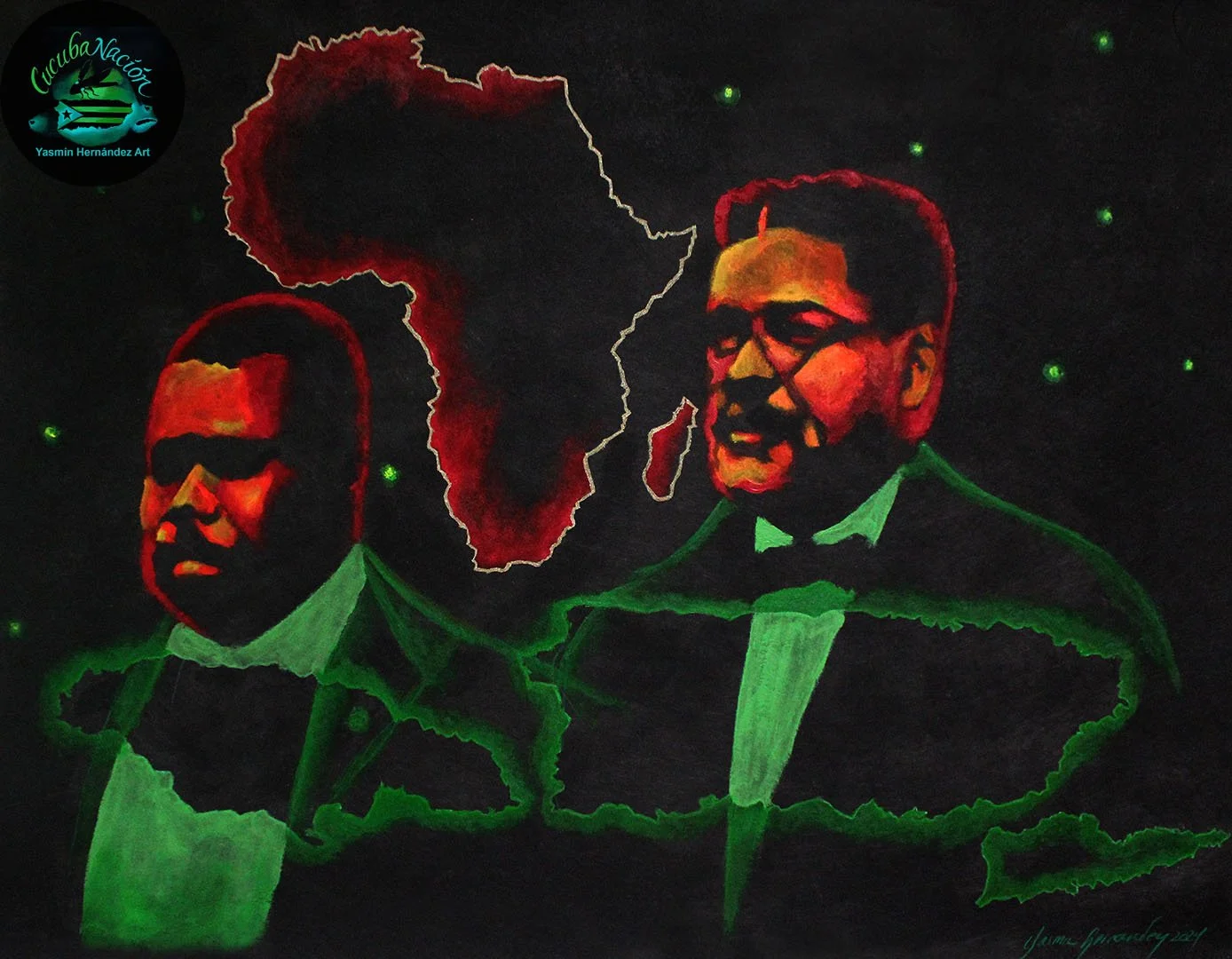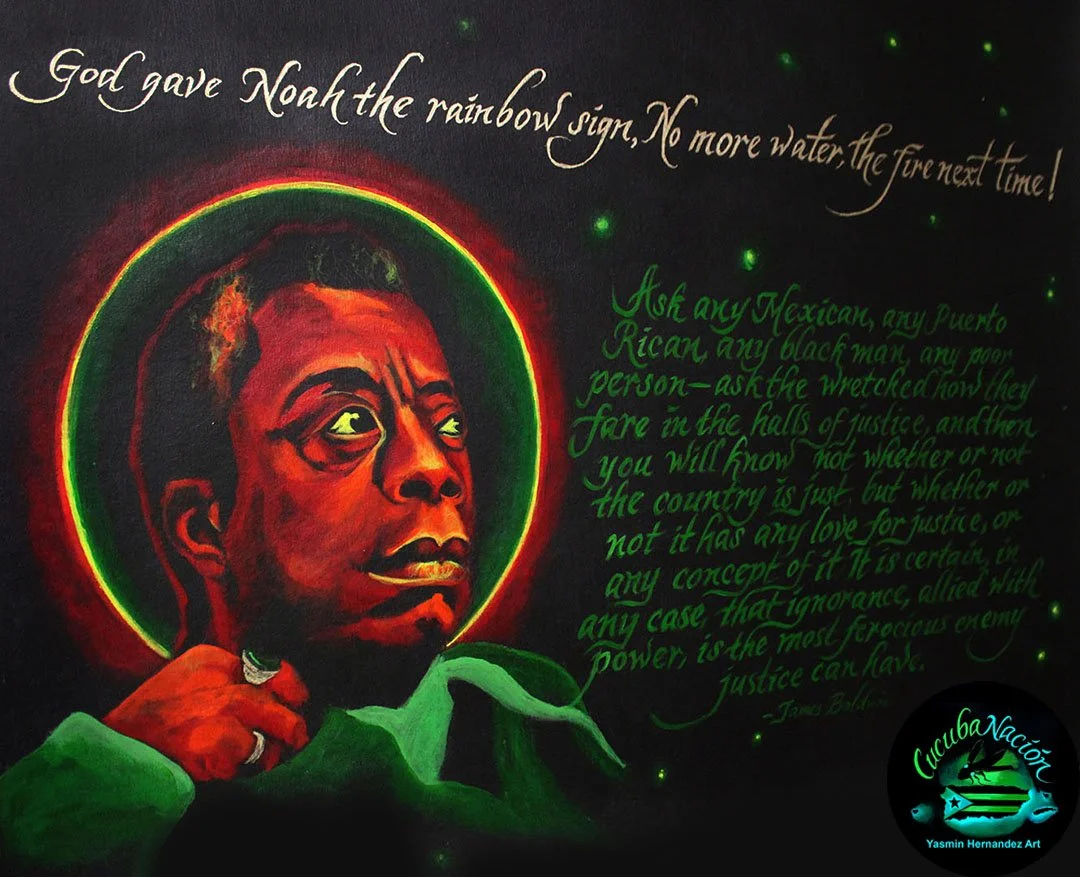
AFRO.BORI.LIBERTARIA
Afro.Bori.Libertaria is an art collaboration between Hormigueros-based artist S. Damary Burgos and Yasmín Hernández. The debut exhibition, supported by the Tiznando el País initiative of la Alianza de Museos de Puerto Rico was on view at la Casa Museo Filiberto Ojeda Ríos in Hormigueros, Puerto Rico from September 23rd, 2024 through March 16, 2025. This home is where clandestine revolutionary Ojeda Ríos lived and was assassinated by the FBI twenty years ago on September 23rd, 2005. The art project is inspired by the library collection of Filiberto Ojeda Ríos which holds books of liberation struggles across the world, with a rich number of those being on Black Liberation. Responding to this collection, the art highlights different individuals and solidarities of importance to Filiberto, the Puerto Rican liberation struggle and the greater Black Liberation struggle of which we are a part. The project also visibilizes various Afro Boricuas who have played key roles in Puerto Rico’s struggle for independence—figures eclipsed from history for being “double threats” as black revolutionaries fighting for liberation. The challenge was exhibiting in a museum that is still the intimate space that was shared by Filiberto and his partner Beatriz. The artworks created and how and where they were exhibited within the space were done in utmost respect to the life, struggle and tragedy that took place there. The exhibit in essence is an ode to the continued victory waged there each day with the preservation of this history and legacy.
Damary and Yasmín first met in 1997 at Taller Puertorriqueño in Philadelphia. They reunited as friends in el oeste de Isla Grande years later. This is their first artistic collaboration.
Scroll below for Images with captions

S. Damary Burgos. "Heliconia de gratitud", 2024. Acrylic on polytab cloth. Birds of Paradise of Gratitude as the title, this work envisions machetes in the colors of these flowers. Afro descendant and Indigenous Boricuas continuing the struggle today are honored in this painting. Their portraits welcome visitors at the entrance to the home.

S. Damary Burgos. "Frutas libertarias", 2024 Acrylic on polytab cloth. (Assata Shakur, Mumia Abu Jamal, Rafael Cancel Miranda, Miguel Sánchez, Pedro Albizu Campos.) Two pieces are created as curtains with tropical fruits found on Filberto’s finca. The silhouettes of pans from Filiberto’s kitchen frame portraits of Afro Indigenous revolutionaries included in the library. The colors of these works contrast countless bullet blasts on the walls and ceilings. The purpose of the art is not to adorn or mask the mortal rawness of the space but rather to remind us of the typical, day to day life lived in this intimate space prior to September 23rd, 2005.

S. Damary Burgos. "Frutas libertarias", 2024 Acrylic on polytab cloth. (Fidel Castro. Dominga de la Cruz Becerril. Hugo Chavéz. Malcolm X. Angela Davis. Filiberto Ojeda Ríos. Nelson Mandela. ) This is one of two artworks created as curtains with tropical fruits found on Filberto’s finca. The silhouettes of pans and muffin tins from his kitchen frame portraits of Afro Indigenous revolutionaries included in the library. The colors of these works contrast countless bullet blasts on the walls and ceilings.

S. Damary Burgos. “Caribe: la pluma defensora de la mar” (Nancy Morejón, Julia Cristina Ortiz Lugo, Jamaica Kincaid) Instalación a Yemaya Atabeira. In the bathroom are “towels” with paintings of scenes of Playa Sucia, Combate and Boquerón. On the floor is a configuration of organic materials collected from these coasts remembering the figures of Atabey-Yemayá. On the other towel, there are three portraits of Antillean writers whose books are also part of the library of Casa FOR. In her book, “A Small Place” Kincaid warns of the displacement of our communities by the wealthy who covet our lands. Their extreme greed exploits our resources and our peoples, turning us into visitors on our own islands. Today the Esencia development threatens Cabo Rojo just 11 km from Playa Sucia, Filiberto’s favorite beach.

Yasmín Hernandez “Solidarity on Sacred Soil”, 2024 Acrílico y tinta sobre pellón 16” x 48” This painting marks the historic moment in which ex political prisoners of the US united with those of Puerto Rico in la Casa Museo Filiberto Ojeda Ríos on September 23rd, 2023. This work includes a quote by Frantz Fanon. Yasmin's paintings, inspired by bioluminescence, use a palette informed by luciérnaga's or fireflies. Their colors red, black, yellow with green glow are also the colors selected by Marcus Garvey to represent black liberation. From left to right: Adolfo Matos Antongiorgi, Edwin Cortes, Masai Ehehosi, Jalil Abdul Muntaqim, Kazi Toure, Ashanti Omowali Alston; Jaan Karl Laaman, Luis Rosa, Jihad Abdulmumit.

Yasmín Hernández, Por la libre”, (25 Years Home) 2024 Acrylic on Polytab cloth, 16” x 48” “Por la libre” was painted to commemorate 25 years since the September 10th, 1999 release of our ex-political prisoners. Also included in this image are Carlos Alberto Torres who wasn’t released until 2010 and Oscar Lopez Rivera, released in 2017. Among the group are our beloved ancestors Elizam Escobar who passed in 2021, and Dylcia Pagán who passed in 2004, a few months before the anniversary. Left to Right: Ida Luz Rodríguez, Edwin Cortés, Alejandrina Torres, Carlos Alberto Torres, Adolfo Matos Antongiorgi, Oscar López Rivera, Luis Rosa, Ricardo Jiménez, Alicia Rodríguez, Roberto Rodríguez, Carmen Valentín, Dylcia Pagán and Elizam Escobar.

Yasmín Hernández, “La oposición patriótica” 2024 Acrylic on polytab cloth, 66” x 50” “It is in great measure an abnormal situation. And it is abnormal in the first place by the very nature of the accuser, as with the accused. The accuser, the FBI, the government of the United States, the power which submerges this nation of ours in the rigors of a brutal colonialism, and its agency that historically has held the responsibility of eliminating the patriotic opposition.” -FOR This piece features the words of Filiberto Ojeda Ríos in his own handwriting, taken from notes he had written during his trial. His handwriting was projected together with images of bullet holes that appear on the back wall of an adjacent space next to where this piece hangs. The purpose of the projections was to provide accuracy and not alter either of these. Creative license was indeed taken in painting the bullet holes in the colors of fireflies, red, black and green, transforming them with Filiberto’s message. Red and green also happen to be the colors of el Ejército Popular Boricua/ Los Macheteros, of which Filiberto was commander. It was designed to hang alongside the original site to offer a space for reflection next to one of the most energetically heavy spaces of the home and to not tamper with that original space.

Yasmín Hernández “Dice África...”, (Africa says...) 2024 Acrylic and ink on polytab cloth, 36” x 30” “Porque como dice Africa, ¡la lucha continua!” This is a double portrait of Dominga de la Cruz Becerril (Ponce, 1909-1981), a member of the Nationalist Party, she is most known for giving Pedro Albizu Campos the title “El Maestro,” and for rescuing the flag when it fell to the ground during the Ponce Massacre in 1937. A fierce revolutionary, she lived in exile in Mexico and Cuba where she was respected for her work towards Puerto Rican liberation. She was also received with acclaim in Moscow where she was given the medical care and rest she needed. This work is inspired by the biography shared in the book Dominga Rescues the Flag by Margaret Randall and Mariana McDonald.

Yasmín Hernández, “AfroAntillas” 2024 Acrylic on polytab cloth, 24” x 30 ¼” Portrait of Jamaican Pan African Nationalist, Marcus Garvey. It was Garvey through his work with the United Negro Improvement Association that decided on the colors red, black and green to represent the global Black Liberation Movement—colors seen on the flags of so many liberated republics across the continent of Africa. He stands together with Arturo Schomburg, historian, writer, collector, activist and “Father of Black Studies.” Born in Puerto Rico, he moved to New York where he became a figure of the Harlem Renaissance. His vast, internationally-renown collection on Black history is now the Schomburg Center for Research in Black Culture in Harlem. Appearing on the painting are the maps of Africa, Jamaica, Puerto Rico and St. Croix (where Schomburg’s mother was born). The image is inspired by a detail of a photo of Garvey and Schomburg at the 1924 funeral of John Edward Bruce. Born into slavery, he was able to escape as a toddler with his mother after his father was sold away. A journalist and powerful voice for black liberation he became a father figure to Garvey and a mentor to Schomburg.

Yasmín Hernández “The Fire Next Time” 2024 (Piri Thomas and James Baldwin) Acrylic on polytab cloth, 30” x 36” “And behold the rainbow that is you.” -Piri Thomas from the poem “Softly Puerto Rican.” “God gave Noah the rainbow sign, no more water, the fire next time.” -Inspired by a biblical verse and included at the opening to Baldwin’s “My Dungeon Shook” in the book of the same title as this painting. This work juxtaposes literary figures Piri Thomas (Cuban and Puerto Rican), poet, novelist, activist born in East Harlem in 1928, and James Baldwin (African American), novelist, essayist, playwright, activist, born in Harlem in 1924. Inspired by their writings aimed at young black and brown men, encouraging a love ethic in our communities, this work borrows its aesthetics from fireflies. With this palette I affirm Puerto Rico’s position within the African Diaspora and with this project I celebrate our solidarity with other diasporic communities.

Yasmín Hernández, James Baldwin detail, “The Fire Next Time” 2024 Acrylic on polytab cloth, 30” x 36” This detail of James Baldwin features a quote from his book, No name in the Street which is found in the library collection of Filiberto Ojeda Ríos. “Ask any Mexican, any Puerto Rican, any black man, any poor person - ask the wretched how they fare in the halls of justice, and then you will know, not whether or not the country is just, but whether or not it has any love for justice, or any concept of it. It is certain, in any case, that ignorance, allied with power, is the most ferocious enemy justice can have.”